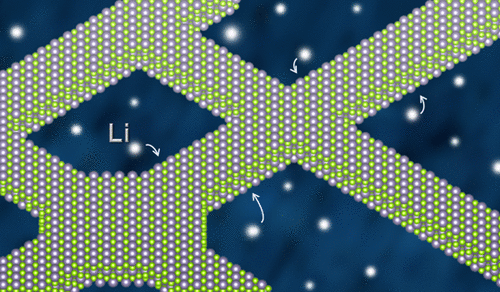当前位置:
X-MOL 学术
›
ACS Appl. Energy Mater.
›
论文详情
Our official English website, www.x-mol.net, welcomes your feedback! (Note: you will need to create a separate account there.)
Two-Dimensional SnSe Nanonetworks: Growth and Evaluation for Li-Ion Battery Applications
ACS Applied Energy Materials ( IF 6.4 ) Pub Date : 2020-06-11 00:00:00 , DOI: 10.1021/acsaem.0c00776 Fionán Davitt 1 , Killian Stokes 2 , Timothy W. Collins 1 , Manuel Roldan-Gutierrez 3 , Fred Robinson 4 , Hugh Geaney 2 , Subhajit Biswas 1 , Shery L.Y. Chang 3 , Kevin M. Ryan 2 , Gillian Reid 4 , Justin D. Holmes 1
ACS Applied Energy Materials ( IF 6.4 ) Pub Date : 2020-06-11 00:00:00 , DOI: 10.1021/acsaem.0c00776 Fionán Davitt 1 , Killian Stokes 2 , Timothy W. Collins 1 , Manuel Roldan-Gutierrez 3 , Fred Robinson 4 , Hugh Geaney 2 , Subhajit Biswas 1 , Shery L.Y. Chang 3 , Kevin M. Ryan 2 , Gillian Reid 4 , Justin D. Holmes 1
Affiliation

|
Engineered two-dimensional (2D) layered materials possess unique physical properties with the potential to improve the performance and endurance of future electronic and energy devices. Here, we report the growth of complex 2D nanonetworks of crystalline tin selenide (SnSe) via liquid injection chemical vapor deposition using a single-source diselenoether precursor. Potential applications of SnSe span a wide range of technological areas, particularly in energy devices. The synthesized SnSe networks were composed of high surface area interconnected junctions of one-dimensional (1D) nanowires in a 2D plane; such complex SnSe nanonetwork structures have not previously been reported. The SnSe networks possessed an orthorhombic Pnma 62 crystal structure throughout, with the individual network branches uniformly orientated along the <011> and <01–1> directions. The width of the individual interconnected nanowire branches ranged from 120 to 250 nm with lengths ranging from 1 to 4 μm. The networks of 1D nanowires had a layer thickness of 88 ± 10 nm. A growth mechanism for the formation of these networks is proposed based on the minimization of high surface energy planes. We also highlight the potential of SnSe nanonetworks as an anode material for Li-ion batteries with galvanostatic testing showing an initial discharge capacity in excess of 1000 mAh g–1 with a 92% capacity retention after 50 cycles at a specific current of 100 mA g–1.
中文翻译:

二维SnSe纳米网络:锂离子电池应用的增长和评估
工程二维(2D)层状材料具有独特的物理特性,有可能改善未来电子和能源设备的性能和耐久性。在这里,我们报告了使用单源二硒醚前体通过液体注入化学气相沉积法生长的结晶硒化硒(SnSe)的复杂2D纳米网络。SnSe的潜在应用涵盖了广泛的技术领域,特别是在能源设备中。合成的SnSe网络由二维平面中一维(1D)纳米线的高表面积互连结组成;这种复杂的SnSe纳米网络结构以前没有被报道过。SnSe网络在整个过程中都具有正交晶体Pnma 62晶体结构,各个网络分支沿<011>和< 01–1>方向。各个相互连接的纳米线分支的宽度范围为120至250 nm,长度范围为1至4μm。一维纳米线网络的层厚度为88±10 nm。基于高表面能平面的最小化,提出了形成这些网络的生长机制。我们还强调了SnSe纳米网络作为锂离子电池阳极材料的潜力,并通过恒流测试表明其初始放电容量超过1000 mAh g。-1与在100mA g的比现有的50个循环后92%的容量保持-1。
更新日期:2020-06-11
中文翻译:

二维SnSe纳米网络:锂离子电池应用的增长和评估
工程二维(2D)层状材料具有独特的物理特性,有可能改善未来电子和能源设备的性能和耐久性。在这里,我们报告了使用单源二硒醚前体通过液体注入化学气相沉积法生长的结晶硒化硒(SnSe)的复杂2D纳米网络。SnSe的潜在应用涵盖了广泛的技术领域,特别是在能源设备中。合成的SnSe网络由二维平面中一维(1D)纳米线的高表面积互连结组成;这种复杂的SnSe纳米网络结构以前没有被报道过。SnSe网络在整个过程中都具有正交晶体Pnma 62晶体结构,各个网络分支沿<011>和< 01–1>方向。各个相互连接的纳米线分支的宽度范围为120至250 nm,长度范围为1至4μm。一维纳米线网络的层厚度为88±10 nm。基于高表面能平面的最小化,提出了形成这些网络的生长机制。我们还强调了SnSe纳米网络作为锂离子电池阳极材料的潜力,并通过恒流测试表明其初始放电容量超过1000 mAh g。-1与在100mA g的比现有的50个循环后92%的容量保持-1。

























 京公网安备 11010802027423号
京公网安备 11010802027423号